


The Undersea & Hyperbaric Medical Society (UHMS) publishes
documents that are free of charge for its members only and can be
purchased by non-members at this address:
https://www.uhms.org/publications/uhm-journal/download-uhm-
journal-pdfs.html
New documents are published every trimester.
Click on the cover images below to access the download links.
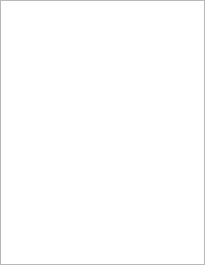
EEG-based brain biomarker supports
hyperbaric oxygen therapy for acute
concussions
Authors:
Daphne Watkins Denham, & Menley A. Denham

Predictive modeling of the performance of the
Zoll Z Vent® under hyperbaric conditions
Authors:
Abigail Winn, Mark Billingsley, Marc Pullis, Daniel
Popa, & Christopher Logue,

Hyperbaric Oxygen Therapy In Surgical Site
Infections: A Clinical Experience
Authors:
Eylem Burcu Kahraman Özlü, Şerif Aytekin, Ezgi
Akar, Arif Tarkan Çalışaneller

Factors related to the prognosis of hyperbaric
oxygen therapy for postoperative paralytic ileus
Authors:
Keishu Onodera, Masakiyo Ishikawa, Manami
Homura, Keita Takahashi, Koji Hoshino, & Yuji
Morimoto,
Undersea & Hyperbaric Medical Society (UHMS)

The South Pacific Underwater Medicine Society (SPUMS), in
collaboration with the European Underwater and Baromedical Society
(EUBS), published the following paid articles in the issues 3 & 4 of
Volume 55 of their journal 2025. These articles are now accessible
through the society login or via the internet address below:
https://www.dhmjournal.com/index.php/purchase-an-embargoed-
article
•
Shared decision-making when considering hyperbaric oxygen
therapy: a systematic review.
Authors: Meijering JR, Risvanoglu N, Nederhoed JH, Hoencamp R,
van Hulst RA, Ubbink DT.
•
Psychosis and scuba diving. Diving and Hyperbaric Medicine..
Authors: Querido AL, Wingelaar TT.
•
Post-traumatic wound infection after diving caused by Vibrio
alginolyticus: a case report.
Authors: Cebrián-López J, Jover-Díaz F, Infante-Urrios A,
Piqueras-Vidal PM, Ortiz de la Tabla-Duccasse V
•
Advances in the delivery of cardiopulmonary resuscitation in a
diving bell.
Authors: Johnson G, Bryson P, Tabner A.
•
Safety and efficacy of continuous glucose monitoring devices in
individuals with diabetes undergoing hyperbaric oxygen therapy: a
scoping review.
Authors: Katsnelson G, Salvatori M, Djaiani G, Greer E, Tarshis J,
Katznelson R.
•
Effects of hyperbaric oxygen therapy initiation latency on auditory
outcomes following acute acoustic trauma.
Authors: Manheim M, Mogilevsky L, Geva A, Knoll O, Zehavi G, Gur I.
•
Shared decision-making when considering hyperbaric oxygen
therapy: a systematic review.
Authors: Meijering JR, Risvanoglu N, Nederhoed JH, Hoencamp R,
van Hulst RA, Ubbink DT.
•
Psychosis and scuba diving.
Authors: Querido AL, Wingelaar TT.
•
Gastric barotrauma following submarine escape training.
Authors: Risberg J, Phillips S, Sletteskog N, Grong K.
•
Comparison of three infusion pumps as an option for intensive care
treatments in monoplace hyperbaric chambers.
Author: Schmitz G.
•
Challenges in the administration of hyperbaric oxygen therapy
(HBOT) for complicated cases in a tertiary care setting.
Authors: Singh D, Mohanty C, Verma R, Kumar S.
These articles are paid for one year, execpt for registered members
of EUBS and SPUMS. Passed the one year embargo, the articles are
free of charge, and can be downloaded through this link:
https://www.dhmjournal.com/index.php/full-journals-embargoed/full-
journals
Note that many of these articles are published through other
organizations and are also integrated in our database.
Diving and Hyperbaric Medicine (DHM)
The Marine Technology Society (MTS) has several technical committees
that publish guidelines.
The latest edition of the Journal is the volume 59 number 1, 2025.
The following articles can be downloaded:
Marine Technology Society

The International Marine Contractors Association (IMCA) published
numerous documents from mid April to mid August 2025.
Competence and Training
•
IMCA C005 - Guidance on competence assurance and assessment:
Remote Systems & ROV Division - June 2025
Environmental Sustainability
•
IN 1708 - Insights from the Ocean Decade and Nature-Inclusive
Design
Diving division
•
IN 1643 – Medical examination of divers: Middle East & India
initiative - June 2025
•
IN 1476 – Medical examination of divers: Asia-Pacific initiative -
June 2025
•
IMCA D087 - Diver Training Schools: Assessment Procedure for
IMCA Recognition of In-Water Diver Training Qualifications - June
2025
•
IMCA D088 - Diving Certification and Verification Initial - June
2025
•
IN 1706 - Diving Supervisor Certification - June 2025
Health and safety
•
IN 1709 - Human and Organisational Performance (HOP)
Marine division
•
IMCA M254 - Guidelines for walk to work operations - August 2025
•
IMCA M189 - eCMID Small Vessel Inspection (<500gt) - July
2025
•
IMCA M270 - IMCA eCMID system annual report 2024/25:
Inspection findings & quality assurance (Jully 2025)
Marine Policy & Regulatory Affairs
•
IN 1707 - Entry into force of the Hong Kong International Convention
for the Safe and Environmentally Sound Recycling of Ships (Hong
Kong Convention) 2009
•
IN 1705 - IMO approves its Net Zero Framework (NZF)
•
IN 1704 - US Coast Guard introduces policies to address Sexual
Assault and Sexual Harassment (SASH) prevention and response on
vessels
Legal, contracts, insurance, & compliance
•
IMCA LCIC017 - Supplementary Insurance Guidance on IMCA's
General Contracting Principles - June 2025
•
IMCA LCIC018 - Supplementary Insurance Guidance on IMCA's
Renewables Contracting Principles - June 2025
•
IMCA LCIC016 - IMCA marine transport & installation renewables
contract - June 2025
Lifting and Rigging
•
IMCA LR008 - Code of practice on the manufacture and safe use
of cable-laid slings and grommets (also IMCA M179) - June 2025
Remote systems & ROV
•
IMCA R002 - Requirements for IMCA-approved ROV introductory
training courses- August 2025
•
IMCA R025 - Requirements for IMCA-approved remote ROV pilot
introductory training courses - August 2025
•
IMCA R006 - ROV system inspection - July 2025

International Marine Contractors Association (IMCA)

•
State of Technology Report: Marine Technology in 2025
Author: Kocak, Donna M.
•
Ocean Energy Learns to Walk Its Own Path.
Authors: Lesemann, Reenst; Terrasa, Kristi.
•
Ocean-Powered Oyster Tumbling: A Review of Techniques and
Opportunities for Emission Reductions.
Authors: Briggs, Candace D.; Grear, Molly E.
•
Coaxial PTO Drives for Wave, Tidal, and Oscillating Water Column Air
Turbines.
Authors: Hanna, John Clarkorcid.
•
Ecobuoys for Scalable Oceanography.
Authors: Nawaz, Anuschehorcid icon; Steele, Michaelorcid icon;
Branch, Ruthorcid icon; Burnett, Davidorcid icon; Liao,
Kuotianorcid icon; Parker, Malloryorcid icon; Roumeli,
Eleftheria.
•
Distributed Acoustic Sensing in the Marine Environment—Where
Are We Now and Where Are We Going?
Authors: Potter, John R.orcid.
•
Seismic Sensing Analysis With Geometric Phase: From Land to Sea.
Authors: Runge, Keithorcid; Beck, Susan
•
Feasibility of Accelerating Incompressible Computational Fluid
Dynamics Simulations With Fault-Tolerant Quantum Computers.
Authors: Garrett, Michael C.; Ponkratov, Dmitryorcid Qiu, Wei.
•
Consequence Analysis Machine Based Power Plant Optimization for
Dynamic Positioning With Battery-Powered Hybrid Propulsion.
Authors: Wu, Yin; Bourgeau, Edward K. Muddusetti, Suman.
•
Building Resilience in Vulnerable Coastal Communities With the
Southeast Water Level Network Initiative.
Authors: Hernandez, Debra; Dorton, Jennifer; Alsbrooks, Cotie; Clark,
Russell; Morano, Kait; Troxler, Tiffany; Glazer, Brian T.;
Fiorentino, Laura; Rome, Nicholas; Wilson, Cassandra;
Dusek, Gregory
•
Ocean Enterprise: Maturing the Global Market for Blue Technology
and Workforce.
Authors: Van Sumeren, Hans; Kocak, Donna M.; Willis, Zdenka;
Hoffman, Caisey.
•
Reflections From Biodiversity COP16: How Innovative Marine
Technology Can Help Achieve the Kunming-Montreal Global
Biodiversity Framework (GBF).
Authors: Brocke, Hannah
•
Soft Underwater Robots: The Perfect Tool for Exploring Fragile
Ecosystems.
Authors: Hall, Robin; Onal, Cagdas D.
•
Navigating Regulatory Frameworks to Benefit From the State of
Diving Technology and Techniques.
Authors: Lombardi, Michael; Mirick, Robert; Chierico, Paulstephen.
•
Station-Keeping Control of AUV Based on Visual Servo Under
Unknown Disturbance.
Authors: Peng, Shilin; Tao, Xinjiang; Hu, Liang; Yu, Haibin; Shi,
Jianguang; Li, Zhu; Tian, Xiaoqing
•
Deep Water Wave Spectral Characteristics in the Northcentral Bay of
Bengal Using Moored Buoy Measurements.
Authors: Ramamoorthy, Janani; Ganesan, Latha; Muthiah,
Krishnaveni; Venkatesan, Ramasamy
•
Green Fuels for Maritime: An Overview of Research Advancements,
Applications, and Challenges.
Authors: Al Baity, Omar A.; Ahmed, Yasser M.; Abdelnaby, Maged;
ElGohary, Mohamed M.
The resolutions and conventions from the International Maritime
Organization (IMO) are available free of charge and can be downloaded
using the links provided in our document titled “Internet links to IMO
resolutions and maritime facts,” located in the subsection “UN
conventions and national laws” within the main section “Documents.”
However, the organization also provides paid documents whose
purpose is to group and better explain the various resolutions and
conventions. Catalogs that list these documents are available in English,
French, Spanish, Arabic, Chinese, and Russian at the following address:
https://www.imo.org/en/publications/Pages/CatalogueAndBookCodeLists
.aspx
International Maritime Organization (IMO)
International Organization for Standardization (ISO)

The standards and guidelines from the International Organization for
Standardization (ISO) are unfortunately not free of charge, despite the
belief that they should be. The organization publishes lists of its
standards in process at this address:
https://www.iso.org/iso-update.html.
Please note the following documents among those listed between mid
April to mide August 2025:
•
ISO 16199:2025: Ships and marine technology — Jacking system
appliances on self-elevating unit — Acceptance tests
•
ISO 20650:2025: Inland navigation vessels — Small floating
working machines — Requirements and test methods
•
ISO 7240-27:2025: Fire detection and alarm systems — Part 27:
Point type fire detectors using a smoke sensor in combination with
a carbon monoxide sensor and, optionally, one or more heat sensors
•
ISO 834-1:2025: Fire-resistance tests — Elements of building
construction — Part 1: General Requirements
•
ISO/TR 22099:2025 : Application examples for using reaction-to-
fire test data for fire safety engineering
•
ISO 16831:2025: Non-destructive testing — Ultrasonic testing —
Characterization and verification of ultrasonic equipment for the
determination of thickness
•
ISO 5175-3:2025: Gas welding equipment — Safety devices —
Part 3: Decomposition blockers for low-pressure acetylene
•
ISO 14732:2025: Welding personnel — Qualification testing of
welding operators and weld
•
ISO 17635:2025: Non-destructive testing of welds — General rules
for metallic materials
•
ISO 16827:2025: Non-destructive testing — Ultrasonic testing —
Characterization and sizing of discontinuities
•
ISO 21207:2025: Corrosion tests in artificial atmospheres —
Accelerated corrosion tests involving alternate exposure to
corrosion-promoting gases, neutral salt-spray and drying
•
ISO 16276-1:2025: Corrosion protection of steel structures by
protective paint systems — Assessment of, and acceptance
criteria for, the adhesion/cohesion (fracture strength) of a coating
— Part 1: Pull-off testing
•
ISO 16276-2:2025: Corrosion protection of steel structures by
protective paint systems — Assessment of, and acceptance
criteria for, the adhesion/cohesion (fracture strength) of a coating
— Part 2: Cross-cut testing and X-cut testing
•
ISO 9612:2025: Acoustics — Determination of occupational noise
exposure — Methodology
•
ISO 14912:2025: Gas analysis — Conversion of gas mixture
composition data
•
ISO 6143:2025: Gas analysis — Comparison methods for
determining and checking the composition of calibration gas
mixtures
The International Chamber of Shipping (ICS), founded in 1921, is a
global trade association representing shipowners and operators. It
advocates for suitable practices in the shipping industry and
represents about 80% of the world's merchant fleet across 40
countries. The ICS offers both free and paid guidelines for various
types of vessels, among which is the paid document below, that have
been recently published:

International Chamber of Shipping (ICS)

The Oil Companies International Marine Forum (OCIMF)
The Oil Companies International Marine Forum (OCIMF), founded in
April 1970, is a prominent authority on marine safety and includes over
100 member companies. It holds consultancy status at the
International Maritime Organization (IMO) and focuses on the safe and
environmentally responsible transportation of crude oil, oil products,
petrochemicals, and gas. It also promotes similar standards in
offshore marine operations management and develops guidelines for
the design, construction, and operation of tankers, barges, and
offshore vessels, incorporating human factors in all its activities. Its
publications can be accessed at https://www.ocimf.org/publications/ .
No new paid documents have been published between January and
mid-April 2025. However, visiting the rich library of this organization is
recommendable. Among the latest paid documents published, please
note the one below:
“Guidelines for the Purchasing and Testing of
SPM Hawsers - Second Edition 2025” is a
publication providing detailed guidance on the
specification, purchasing, testing, and design
particulars of mooring hawsers.
This second edition includes rope design
particulars and compliance certificates.
“Guide to the Vetting Process 15th Edition”
This publication, now in its 15th edition, provides
guidance on ship inspections and the vetting
process and is designed to assist tanker crews
and personnel ashore to better understand, and
to be better prepared for, vetting inspections.

International Association of Independent Tanker Owners
(INTERTANKO)
INTERTANKO is a trade association that represents independent tanker
owners globally. It deals with operational, technical, legal, and
commercial issues affecting its members. The organization offers a
database of free and paid documents to its members. Nonmembers
can also buy the paid documents at the following address:
https://www.intertanko.com/info-centre/intertanko-
publications/infocentrebooklistings .
Among these paid documents, note the guidelines below:

“Marine Professional” is the official membership
magazine of the IMarEST.
It is published quarterly and available to all
members in digital and print format.
The Institute of Marine Engineering Science and
Technology (IMarEST)
The Institute of Marine Engineering, Science and Technology
(IMarEST) is an international, multidisciplinary professional body that
unites marine engineers, scientists, and technologists. The organization
offers news and paid articles, accessible via the "News" button on their
website's navigation bar. Among these publications, note the magazine
below:
The International Maritime Health Association (IMHA)
The International Maritime Health Association (IMHA) is a non-
governmental organization dedicated to improving health services for
seafarers, fishermen, and port workers. It promotes high healthcare
and safety standards at sea and provides links to guidelines from
international organizations such as the EU, ILO, and IMO. Additionally,
the organization sells the books such as the one below:
“International Medical Guide for Seafarers and
Fishers”
This medical guide from the International
Chamber of Shipping, is suitable for use on all
ships and fishing vessels worldwide, as well as
in onshore safety departments, medical
assistance centers, and training institutions
supporting seafarers and fishers.



The Nautical Institute (NI)
The Nautical Institute (NI) is an international professional organization
dedicated to advancing professionalism, best practices, and safety in
the maritime industry. It comprises four departments: membership
and branches, information and publishing, research and relationships,
and qualifications. The institute's website features a bookshop where,
among other documents, the following maritime-related books are
sold.

International Labour Organization (ILO)
The International Labour Organization (ILO), a specialized agency of the
United Nations, promotes social and economic justice through
international labour standards. It provides free resolutions and
conventions and sells documents, the catalog of which is available at
https://www.ilo.org/research-and-publications#flagship

NORSOK standards
The NORSOK standards are developed by the Norwegian petroleum
industry. Their purpose is to ensure safety, enhance value, and
promote cost-effectiveness in petroleum industry developments and
operations. These standards aim to replace oil company specifications
and serve as references in regulatory authorities’ regulations.
Website: https://standard.no/en/sectors/petroleum/norsok-standards/
To the best of our knowledge, no new documents related to diving,
ROVs, and AUVs have been published since late 2024. However, note
the document “NORSOK M-501 Revision 7 Systems Guide 2025
Edition", below, related to offshore works:

Helicopter Operation Procedures for Ships:
Essentials covers four key lessons for safe
operations: considerations before operations,
preparing for arrival, communicating before,
and during operations. It is based on the best-
selling Guide to Helicopter/Ship Operations and
provides updated guidance for crews to
enhance safety and efficiency.
The International Chamber of Shipping and
VCSF highlight the dangers of vehicle fires on
certain vessels and provide guidelines to help
crews and operators prepare for such
incidents. These guidelines focus on response
measures and acknowledge limitations due to
vessel design and training.
The following paid articles have been published from mid April to Mid
August 2025
•
UK offshore wind consent: racing against time
Author: Samantha Andrews
•
Harnessing wind power key to cleaner shipping
Author: Samantha Andrews
•
Global shipping losses reach record low amid rising risks
Author: Samantha Andrews
•
Artistry and creativity make ‘best’ naval engineers
Author: Samantha Andrews
•
Lessons learned at sea: safety insights from 2025
Author: Charlie Bartlett
•
Experts' latest responses as IMO’s climate deal sets course for net
zero shipping
Authors: Amy McLellan
•
Understanding different offshore wind foundations
Author: Claudia Scragg
Also note these two recent free-access articles in direct relation to
diving and ROV activities:
•
UK’s growing offshore wind industry: engineering and financial
challenges
•
Seabed can provide 50 percent of energy requirements by 2050


Click on the
octopus to return to
the top of the page
The Ship to Ship Transfer Guide for Petroleum,
Chemicals, and Liquefied Gases is a key
resource for safe STS operations.
This updated edition includes new chapters on
human factors and innovative technologies,
revised personnel transfer protocols, and
enhanced equipment guidelines.
The 2024–2025 ICS Maritime Barometer is an
annual survey assessing risks and confidence
among maritime leaders. C-suite executives,
primarily shipowners and ship managers,
shared their views on factors affecting their
decisions and confidence in handling ongoing
challenges.
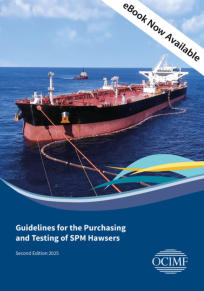

The document "Shiphandling: The Beautiful
Game" discusses common challenges, such as
navigation in restricted visibility or channels,
turning in confined waters and ports,
maintaining situational awareness, and avoiding
the distractions that have become more
common with technological advances.
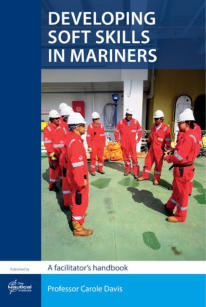
Soft skills are interpersonal and emotional skills
that help people to manage social situations,
build relationships, and work effectively with
others. "Developing Soft Skills in Mariners" is a
practical manual for trainers that complements
IMO based courses.

"A Simulation Instructor's Handbook: A Practical
Guide - 2nd Edition" complements the IMO
Model Course and is designed for anyone using
simulators in an adult learning environment. It
covers the theory behind adult learning and the
use of simulators in training programs and
guides instructors through setting up,
conducting, and evaluating a successful
simulation exercise.
The full list of publications can be opened by
clicking on the image of the cover to the side.
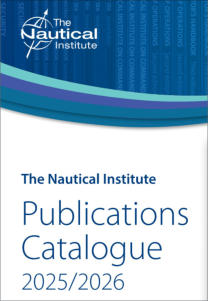

The ILO "World Employment and Social Outlook:
Trends 2025 report" analyzes global labour
market trends, highlighting challenges such as
a slow economic recovery, persistent youth
unemployment, and gender disparities.
This report also examines structural issues
affecting workers worldwide and offers
insights into regional and global patterns
shaping the future of work.
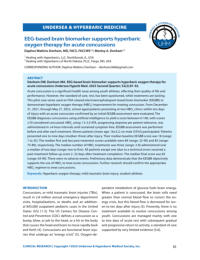

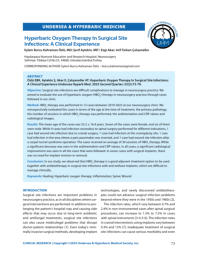
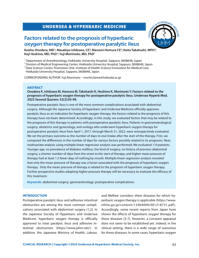

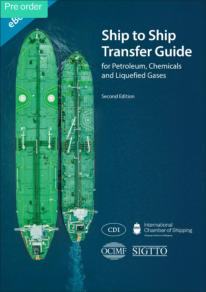
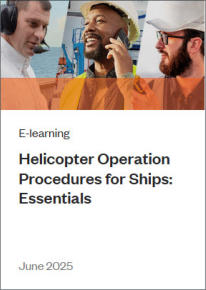

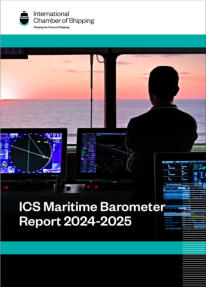
“Recommendation for converting Inland Tank-
Barges from Open to Closed Cargo Operations in
South and Central America”
This paper gives guidance to regional barge
companies in South and Central America on
how to build or convert their inland barges for
cargo operations under closed conditions, to
improve safety and conform to international
standards.
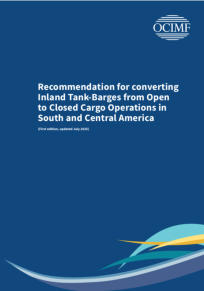
“Unified Approach to Verification, Validation and
Assurance of Single Fault Tolerance in Dynamic
Positioning Systems”
This guidance provides a transparent
framework that shows the relationships and
responsibilities between stakeholders involved in
the design, verification and validation process
for dynamic positioning (DP) systems of
Equipment Classes 2 and 3.
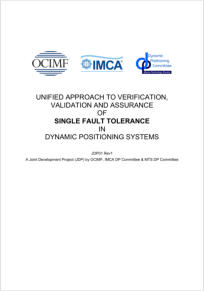
“Onshore Power Supply Systems:
Recommendations for Tankers and Terminals”
The Onshore Power Supply (OPS) offers
environmental benefits by allowing ships to use
shore power instead of diesel generators,
lowering emissions and improving air quality.
This paper provides guidance for OPS design,
implementation, and operation.


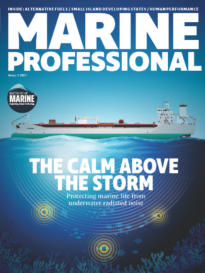
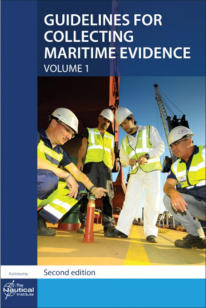
“Guidelines for Collecting Maritime Evidence -
Volume 1 - 2nd Edition”
This book teaches mariners how to meet
evidence requirements while ensuring safety
and environmental protection.
Experts share their views on evidence collection
relevant to various regulations.
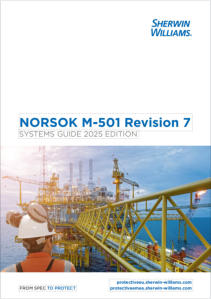
This document serves as a reference for the
selection, application, and maintenance of
protective coating systems used in offshore
and related industries, considering the
protection's efficiency and durability, as well as
addressing health, safety, and environmental
impacts.

Effect of hyperbaric air exposure with
prolonged oxygen inhalation during
decompression on the cardiovascular function
in divers
Authors:
Liu Wenwu, Zhang Tingting, Yin Lijun, Xu Jiajun,
Yu Xuhua, Wang Shifeng,

Position change during hyperbaric oxygen
therapy for arterial gas embolism
Authors:
Naoto Jingami, Takayuki Nitta, Yoshitaka Ishiguro,
Yudai Takatani, Tomoyuki Yunoki, Shigeru
Ohtsuru,

Pseudoephedrine prophylaxis does not prevent
middle ear barotrauma in hyperbaric oxygen
herapy.
Authors:
Siamak Moayedi, ndreas Gizaw, Sarah Sweet,
Kinjal Sethuraman, Michael Witting

Efficacy of hyperbaric oxygen salvage therapy
for sudden sensorineural hearing loss after
ineffective primary treatment in the Slovak
Republic
Authors:
Zdenka Krajcovicova, Rastislav Zigo, Vladimír
Melus, Eva Kralova,

Clostridial Myonecrosis (Gas Gangrene)
Authors:
Robert P. Weenink, Georgios F. Giannakopoulos,
Robert A. van Hulst,

Arterial Insufficiencies: Central Retinal Artery
Occlusion
Authors:
Heather Murphy-Lavoie, Frank Butler, Catherine
Hagan,

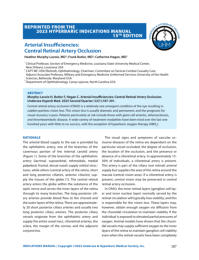
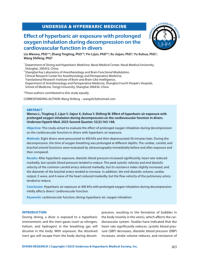
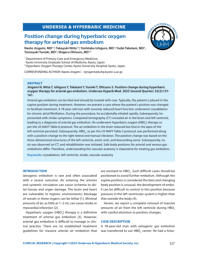
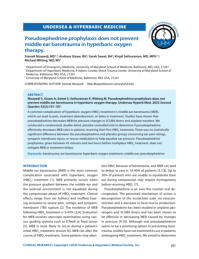
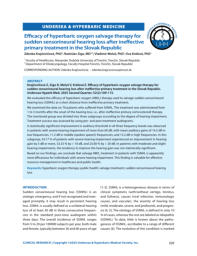

Visualization and Bibliometric Analysis of the
Research Progress and Trends of Air Embolism
Authors:
Yuehong Ma, Wenying Lv, Shuyi Pan, Dazhi Guo

The Role of Hyperbaric Oxygen Therapy for
Severe Frostbite Injury: Insights from a
Retrospective Cohort at a High Volume Burn
Center
Authors:
Thomas Masters, Margot Samson, Jeff Tucci,
Alexandra M Lacey, Charlotte Rogers, Alexandra
Coward, Gopal V Punjabi, Rachel M. Nygaard,

Arterial Gas Embolism After CT-Guided Lung
Biopsy
Authors:
William Zhu, Siamak Moayedi, Kinjal Sethuraman,
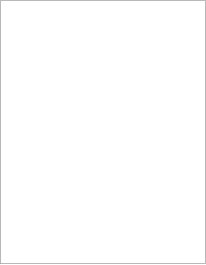
Definition of delayed-onset neurologic sequelae:
A review article
Authors:
Alik Dakessian, Zachary Hagen, Eugenio R
Rocksmith, Kinjal N Sethuraman,















